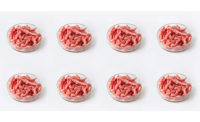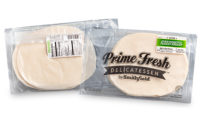One thing you'll notice about site visits is that it typically starts at the cutline "clean rooms" and works its way back to the barn. It never ceases to amaze me how often the facility operators ask me if I want to actually see the kill or the barn as if it's not critical to why I'm there. Quite frankly I've stopped visiting the cut floors and spend 90 percent of my time on the barns, the kill and de-hiding. The government focuses the bulk of their energies and time on the gut table animal health and pre-operational inspections. This is not where E. coli O157:H7 originates from!
Once you understand that the industry's current highest risk in the media is illness from a pathogen that comes from the intestines or manure, it's easy to bring intelligent input to a harvest audit. Unfortunately my experience is that when I point out manure contaminants that are transferred from a piece of equipment to piece of equipment, hide on the animal to a worker and back to the hide on the next animal etc., the production personnel often explain how they have a cleaning system downstream such as hot water or lactic acid. Every step in the process can and should be an opportunity to reduce the risk from getting downstream and to reduce the bacteria and pathogen load on the downstream interventions.
Let's walk through a few checklist items that we laymen can point out when doing a harvest audit and ensure greater safety for all our kids: (CP – Critical Point; CCP – Critical Control Point)
* Pre-op to see how the plant looks prior to start up. Look for a visually clean plant, including walls, floors and drains, as well as a good smell. Ensure that sanitation areas (for knives etc.) are actually emptied each day and cleaned and sanitized. (It might surprise you to know that I've seen operations where this was not done!)
* Observe how people arrive, proceed to and prepare their areas. Observe how they enter, clean their hands, dress and prepare to start work.
* I like to go to the barn to observe the cleanliness of the barn and animals and always ask how much manure and mud is on the animals when they come in. I also ask:
- What they do if there is a large amount of manure and mud on the animals entering the barn
- Do they record the findings and how and where is it recorded?
- What if any action are they taking or are they only recording?
- Do they have a mechanism or system in place to get information back to the farmer?
* At this point the ideal intervention is hide-on hydrogen peroxide wash, validated intervention - CP
* At the start of the line, observe the amount of animal manure and mud and again observe the cleanliness of the animals.
* Ensure when knocked that the animal does not fall on the ground. Progressive establishments have baskets that lower the animals to keep them off the floor. If the animal does drop to the floor, all surfaces must be sanitized prior to the next animal entering the area.
* When de-hiding is performed, ensure that between each of the initial cuts, knives are sanitized and at the correct time temperature (validate) - CP
* As the animal travels down the line, hooves should not come into contact with the employees on the line, and animals are presented away from the employees removing the hide.
* There should be stations along the initial de-hiding line where the job of de-hiding is being verified, and trimming and steam vacuuming is occurring.
* Ensure the hide is pulled down over the head of the animal and ensure no residual hair is left on the carcass.
* Take note of the amount of, if any, material in the air.
* Once the hide is removed, ensure the exposed carcass goes through a pre-evisceration intervention spray, validate intervention - CP
* The organs should be removed on a proper table that is continually being sanitized with water at 180F plus, validate temperature - CP
* Hearts should be removed (plucked) and go through an initial regular water wash, then lactic or other wash and followed by a final rinse.
* Once the organs are removed, another intervention spray is performed, a post evisceration (validate), a visual inspection, then a trim steam vacuum, validate intervention spray - CP
* validated heat treatment of the carcass, or steam - CCP
* Prior to the chiller, there is another intervention in the form of a leave on spray (validate) - CP
* When the carcass enters the cooler, check the frequency of cleaning performed on the cooler, the temperature of the cooler, and the spacing of carcasses in the cooler. (Carcasses should not be touching as it traps heat); validate temperature - CP
* Become informed of the time temperature of the carcasses prior to the boning line, how long the carcass was in the cooler and the temperature of the carcass prior to boning.
* The ideal is to have an intervention spray as carcass enters the boning line (validate) and carcass visual inspection. - CP



Report Abusive Comment